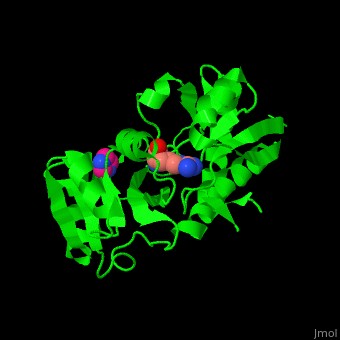ABC transporter
From Proteopedia
(Difference between revisions)
| Line 4: | Line 4: | ||
== Function == | == Function == | ||
| - | '''A'''TP '''B'''inding '''C'''assette (ABC) '''[[Transporters]]''' are ATP-dependent membrane proteins critical for most aspects of cell physiology, including the uptake of nutrients (importers) and elimination of waste products and energy generation (exporters) which are predominantly expressed in excretory organs, such as the liver, intestine, blood-brain barrier, blood-testes barrier, placenta, and kidney<ref name="Kidney"/><ref name="FourDomainsABCT"/>. There are many ABC Transporters in organisms, for instance, there are 28 in yeast, 58 in ''Caenorhabditis'', 51 in ''Drosophila'',129 in ''Arabadopsis'',and the 69 ABC transporters in ''E. coli'' account for almost 5% of its genomic coding capacity<ref name="EColi"/>. ABC transporter protein translocates substrates across membranes. It contains a Solute Binding Domain (SBD). '''CFTR''' (Cystic Fibrosis Transmembrane Regulator) translocates chloride and thiocyanate. It contains a nucleotide binding domain (NBD). | + | '''A'''TP '''B'''inding '''C'''assette (ABC) '''[[Transporters]]''' are ATP-dependent membrane proteins critical for most aspects of cell physiology, including the uptake of nutrients (importers) and elimination of waste products and energy generation (exporters) which are predominantly expressed in excretory organs, such as the liver, intestine, blood-brain barrier, blood-testes barrier, placenta, and kidney<ref name="Kidney"/><ref name="FourDomainsABCT"/>. There are many ABC Transporters in organisms, for instance, there are 28 in yeast, 58 in ''Caenorhabditis'', 51 in ''Drosophila'',129 in ''Arabadopsis'',and the 69 ABC transporters in ''E. coli'' account for almost 5% of its genomic coding capacity<ref name="EColi"/>. ABC transporter protein translocates substrates across membranes. It contains a Solute Binding Domain (SBD). '''CFTR''' (Cystic Fibrosis Transmembrane Regulator) translocates chloride and thiocyanate. It contains a nucleotide binding domain (NBD). In humans the ABC transporters are classified into subfamilies, i.e. ABCB6 is ABC subfamily B member 6. ABC Transporters have two main functionalities acting either as exporters or importers. '''ABC ''Exporters''''' release bound drugs to the extracellular environment, while '''ABC ''Importers''''' accept substrate molecules from their relevant substrate-binding proteins<ref name="biochembook"/>. For instance the Vitamin B12 transporter BtuCD (PDB [[1l7v]]) is a binding protein-dependent ABC transporter system that uses the power of ATP hydrolysis to pump vitamin B12 into the cytoplasm of E. coli<ref name="BtuCD-Ecoli"/>. <br /> |
*For details of '''serotonin transporter''' see [[Serotonin Transporter]]<br /> | *For details of '''serotonin transporter''' see [[Serotonin Transporter]]<br /> | ||
*For details of '''sugar transporter''' see [[Glut3]], [[Sanbox glut3]] and [[GLUT4]]<br /> | *For details of '''sugar transporter''' see [[Glut3]], [[Sanbox glut3]] and [[GLUT4]]<br /> | ||
| Line 16: | Line 16: | ||
== Disease == | == Disease == | ||
| - | There are currently 50 known ABC transporters in human. Of these there are 13 genetic diseases known to be associated with 14 of them. Among the diseases are cystic fibrosis, Stargardt disease, age-related macular degeneration and others. '''ABC Exporters''' use ATP to drive import and export functions providing multidrug resistance. In eukaryoles, for instance, ABC Transporters are problematic because they export therapeutic drugs such as those used in chemotherapy regimens, which must be changed frequently to avoid the rejection of the drugs<ref name="biochembook"/>. | + | There are currently 50 known ABC transporters in human. Of these there are 13 genetic diseases known to be associated with 14 of them. Among the diseases are cystic fibrosis, Stargardt disease, age-related macular degeneration and others. Mutations in CFTR lead to Cystic Fibrosis. '''ABC Exporters''' use ATP to drive import and export functions providing multidrug resistance. In eukaryoles, for instance, ABC Transporters are problematic because they export therapeutic drugs such as those used in chemotherapy regimens, which must be changed frequently to avoid the rejection of the drugs<ref name="biochembook"/>. |
</StructureSection> | </StructureSection> | ||
Revision as of 11:29, 15 February 2017
| |||||||||||
3D Structures of ABC transporter
Updated on 15-February-2017
References
- ↑ 1.0 1.1 Huls et al. The Role of ATP Binding Cassette Transporters in Tissue Defense and Organ Regeneration. Journal of Pharmacology and Experimental Therapeutics, 2008; 328 (1)
- ↑ 2.0 2.1 2.2 Garrett R, Grisham CM. Biochemistry. 2008. 1059 pages
- ↑ 3.0 3.1 Linton KJ, Higgins CF. The Escherichia coli ATP-binding cassette (ABC) proteins. Mol Microbiol 28: 5–13, 1998
- ↑ 4.0 4.1 4.2 Linton KJ. Structure and Function of ABC Transporters. Physiology 22: 122-130, 2007; doi:10.1152/physiol.00046.2006
- ↑ 5.0 5.1 Borths EL. Structural and biochemical characterization of the vitamin B12 ABC transporter, BtuCD-F. Dissertation (Ph.D.), California Institute of Technology. 2005
Proteopedia Page Contributors and Editors (what is this?)
Michal Harel, Alexander Berchansky, Joel L. Sussman, Zina Saadi

